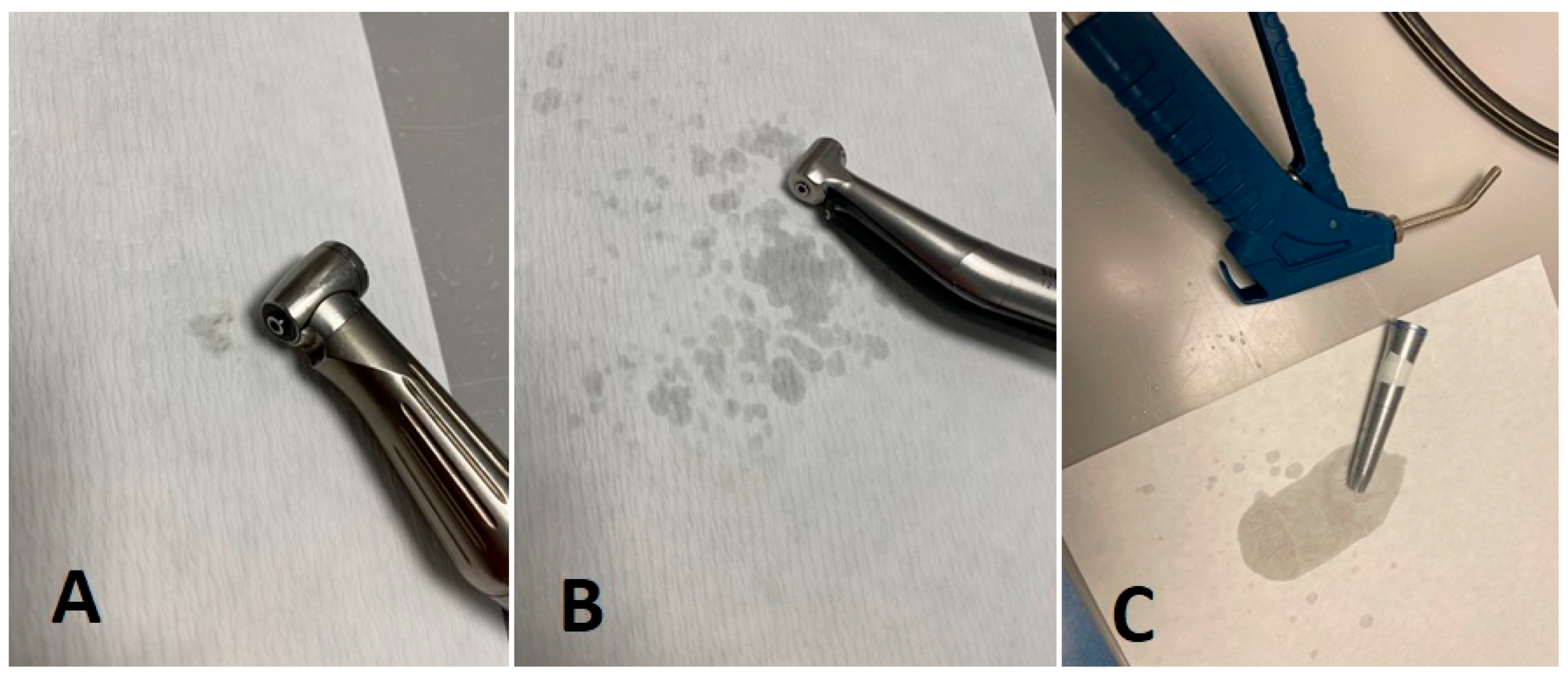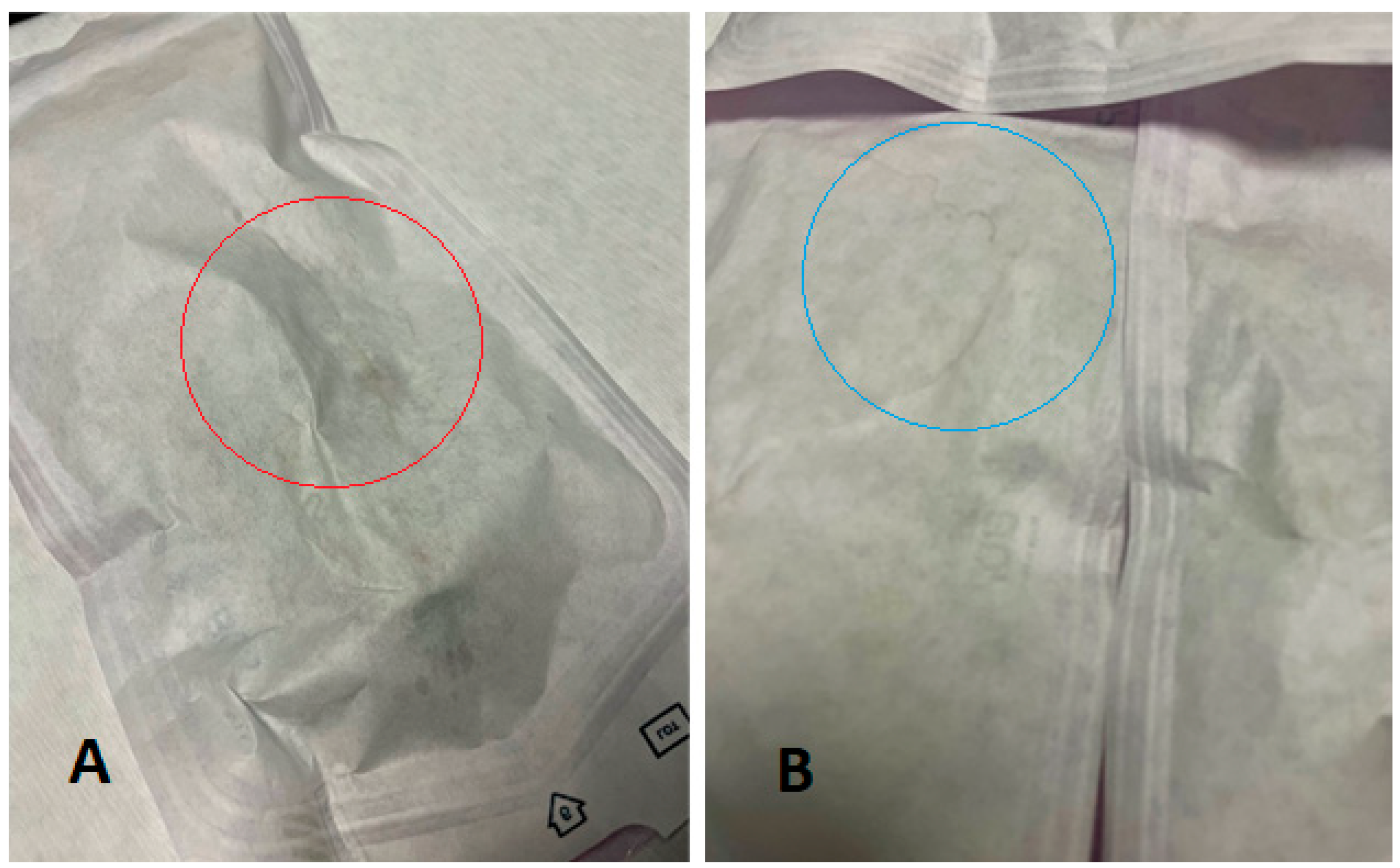Compliance of the Dryness of Dental Handpieces for Their Sterilization under Various Treatment Conditions
Abstract
1. Introduction
2. Materials and Methods
2.1. Protocols
2.2. Statistical Analysis
3. Results
4. Discussion
5. Conclusions
Author Contributions
Funding
Institutional Review Board Statement
Informed Consent Statement
Data Availability Statement
Conflicts of Interest
Abbreviations
| DH | Dental handpiece |
| HIV | Human Immunodeficiency Virus |
References
- Cicciù, M. Water Contamination Risks at the Dental Clinic. Biology 2020, 9, 43. [Google Scholar] [CrossRef] [PubMed]
- Saccucci, M.; Ierardo, G.; Protano, C.; Vitali, M.; Polimeni, A. How to manage the biological risk in a dental clinic: Current and future perspectives. Minerva Stomatol. 2017, 66, 232–239. [Google Scholar] [CrossRef] [PubMed]
- Innes, N.; Johnson, I.G.; Al-Yaseen, W.; Harris, R.; Jones, R.; Kc, S.; McGregor, S.; Robertson, M.; Wade, W.G.; Gallagher, J.E. A systematic review of droplet and aerosol generation in dentistry. J. Dent. 2021, 105, 103556. [Google Scholar] [CrossRef] [PubMed]
- Ionescu, A.C.; Cagetti, M.G.; Ferracane, J.L.; Garcia-Godoy, F.; Brambilla, E. Topographic aspects of airborne contamination caused by the use of dental handpieces in the operative environment. J. Am. Dent. Assoc. 2020, 151, 660–667. [Google Scholar] [CrossRef]
- Petti, S.; Moroni, C.; Messano, G.A.; Polimeni, A. Detection of oral streptococci in dental unit water lines after therapy with air turbine handpiece: Biological fluid retractation more frequent than expected. Future Microbiol. 2013, 8, 413–421. [Google Scholar] [CrossRef] [PubMed]
- Schalli, M.; Kogler, B.; Miorini, T.; Gehrer, M.; Reinthaler, F.F. High-Speed Dental Instruments: An Investigation of Protein-Contaminated Dental Handpieces with the Bicinchoninic Acid Assay in Dental Offices in Styria, Austria. Int. J. Environ. Res. Public Health 2023, 20, 1670. [Google Scholar] [CrossRef] [PubMed]
- Chanchareonsook, N.; Ling, M.L.; Sim, Q.X.; Teoh, K.H.; Tan, K.; Tan, B.H.; Fong, K.Y.; Poon, C.Y. Failure of sterilization in a dental outpatient facility: Investigation, risk assessment, and management. Medicine 2022, 101, e29815. [Google Scholar] [CrossRef] [PubMed]
- France 3 Occitanie. 5000 Patients Potentiellement Contaminés par le VIH ou l’hépatite Suite à un Problème de Stérilisation de Matériel. Available online: https://france3-regions.francetvinfo.fr/occitanie/hautes-pyrenees/tarbes/suite-a-un-defaut-de-sterilisation-de-materiel-5-000-patients-invites-a-se-faire-depister-pour-des-hepatites-et-pour-le-vih-2852714.html (accessed on 12 February 2024).
- Wirthlin, M.R.; Marshall, G.W.; Rowland, R.W. Formation and Decontamination of Biofilms in Dental Unit Waterlines. J. Periodontol. 2003, 74, 1595–1609. [Google Scholar] [CrossRef] [PubMed]
- Offner, D.; Brisset, L.; Musset, A.M. Evaluation of the mechanical cleaning efficacy of dental handpieces. J. Hosp. Infect. 2019, 103, e73–e80. [Google Scholar] [CrossRef] [PubMed]
- Offner, D.; Fernandez de Grado, G.; Wurtz, A.; Musset, A.M. Pré-désinfection et nettoyage des dispositifs médicaux: Outils et normes. Le Fil Dent. 2019, 153, 28–32. [Google Scholar]
- Deasy, E.C.; Scott, T.A.; Swan, J.S.; O’Donnell, M.J.; Coleman, D.C. Effective cleaning and decontamination of the internal air and water channels, heads and head-gears of multiple contra-angle dental handpieces using an enzymatic detergent and automated washer-disinfection in a dental hospital setting. J. Hosp. Infect. 2022, 128, 80–88. [Google Scholar] [CrossRef] [PubMed]
- Panta, G.; Richardson, A.K.; Shaw, I.C. Effectiveness of autoclaving in sterilizing reusable medical devices in healthcare facilities. J. Infect. Dev. Ctries. 2019, 13, 858–864. [Google Scholar] [CrossRef] [PubMed]
- Laneve, E.; Raddato, B.; Dioguardi, M.; Di Gioia, G.; Troiano, G.; Lo Muzio, L. Sterilisation in Dentistry: A Review of the Literature. Int. J. Dent. 2019, 2019, 6507286. [Google Scholar] [CrossRef] [PubMed]
- Kudhail, R. Can oil lubricated dental handpieces be sterilized? Part 2. Literature review. Dent. Update 2013, 40, 630–636. [Google Scholar] [CrossRef] [PubMed]
- Offner, D.; Scholler, J.; Musset, A.M. Cleaning of dental handpieces and associated parameters: Internal and external cleaning, drying and rotation. Am. J. Dent. 2021, 34, 137–142. [Google Scholar] [PubMed]
- Bhandary, N.; Desai, A.; Shetty, Y.B. High speed handpieces. J. Int. Oral Health 2014, 6, 130–132. [Google Scholar] [PubMed]



| Protocol 1: | Washer–Disinfector | ⇒ | ⇒ | ⇒ | Test |
| Protocol 2: | Washer–Disinfector | ⇒ | ⇒ | Sterilization | Test |
| Protocol 3: | Washer–Disinfector | Compressed air | ⇒ | Sterilization | Test |
| Protocol 4: | Washer–Disinfector | ⇒ | Lubrication | Sterilization | Test |
| Protocol 5: | Washer–Disinfector | Compressed air | Lubrication | Sterilization | Test |
 |
Disclaimer/Publisher’s Note: The statements, opinions and data contained in all publications are solely those of the individual author(s) and contributor(s) and not of MDPI and/or the editor(s). MDPI and/or the editor(s) disclaim responsibility for any injury to people or property resulting from any ideas, methods, instructions or products referred to in the content. |
© 2024 by the authors. Licensee MDPI, Basel, Switzerland. This article is an open access article distributed under the terms and conditions of the Creative Commons Attribution (CC BY) license (https://creativecommons.org/licenses/by/4.0/).
Share and Cite
Fruhauf, A.; Fernandez de Grado, G.; Scholler, J.; Offner, D. Compliance of the Dryness of Dental Handpieces for Their Sterilization under Various Treatment Conditions. Hygiene 2024, 4, 231-237. https://doi.org/10.3390/hygiene4020019
Fruhauf A, Fernandez de Grado G, Scholler J, Offner D. Compliance of the Dryness of Dental Handpieces for Their Sterilization under Various Treatment Conditions. Hygiene. 2024; 4(2):231-237. https://doi.org/10.3390/hygiene4020019
Chicago/Turabian StyleFruhauf, Axel, Gabriel Fernandez de Grado, Julie Scholler, and Damien Offner. 2024. "Compliance of the Dryness of Dental Handpieces for Their Sterilization under Various Treatment Conditions" Hygiene 4, no. 2: 231-237. https://doi.org/10.3390/hygiene4020019
APA StyleFruhauf, A., Fernandez de Grado, G., Scholler, J., & Offner, D. (2024). Compliance of the Dryness of Dental Handpieces for Their Sterilization under Various Treatment Conditions. Hygiene, 4(2), 231-237. https://doi.org/10.3390/hygiene4020019






